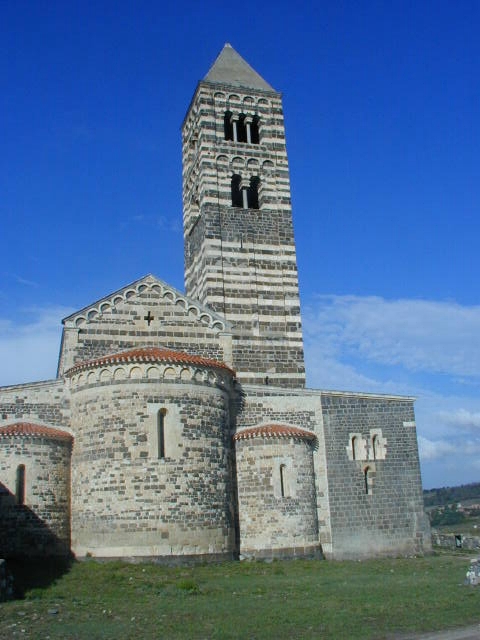Trinità di Saccargia is one of the most significant and picturesque historical sites in Sardinia, Italy. It is a Romanesque-style church located in the northwestern part of the island, near the town of Codrongianus, in the province of Sassari.
Key Features and Historical Significance:
1. Architectural Style:
- Romanesque Architecture: The Church of Trinità di Saccargia is an excellent example of Sardinian Romanesque architecture, with distinctive Lombard influences. It is characterized by simple yet elegant stonework, horizontal bands of contrasting white and black stone, and rounded arches.
- Stonework: The church is made from local limestone and basalt stone, giving it a striking black-and-white appearance. The use of these contrasting stones is a hallmark of the Sardinian Romanesque style.
- Facade: The main facade of the church has a central arch and a rose window, which is typical of Romanesque churches. The bell tower is a tall, slender structure that rises above the church, and it too is built in the same distinct style, with decorative stonework.
2. Historical Background:
- Origins: The church was likely founded in the 12th century, although its construction might have started in the early 1100s. It is often attributed to the Judicates of Sardinia, who were powerful rulers during the island’s medieval period. Specifically, it was built by the Giudicato of Torres, one of the four medieval states of Sardinia.
- Religious Significance: The church is dedicated to the Holy Trinity (Trinità), and it likely served as a monastic and pilgrimage site. It also played an important role in the spread of Christianity on the island and in consolidating the religious influence of the Pisan and Lombard communities.
- Monastic Connection: Some believe that the church may have been associated with a monastic order, and it could have been a site of religious rituals, as well as a center for spiritual guidance and learning.
3. Artistic and Religious Elements:
- Interior: The interior of Trinità di Saccargia is simple but beautiful, with some medieval frescoes and carvings still visible in parts of the church. Many of the frescoes have been worn down over the centuries but can still give visitors a sense of the church’s former grandeur.
- Chapel and Altars: The church has a small, yet significant chapel, and the altar area is adorned with stone carvings, which are typical of the Romanesque period. It reflects the religious devotion of the time and the cultural exchange between Sardinia and the mainland.
- Famous Decorations: While much of the church’s interior has been stripped or damaged by time, traces of medieval art, including symbols and inscriptions, can still be found in the structure, offering insight into Sardinia’s past.
4. Strategic Location:
- The church is situated in a rural area surrounded by rolling hills and open fields, offering a tranquil and picturesque setting. Its location, in the middle of the Saccargia Valley, gave it a prominent place in the Sardinian landscape and religious geography.
- The site of Trinità di Saccargia is near the ancient Roman road, which connected various parts of the island, making it a convenient stop for travelers and pilgrims.
5. Preservation and Visits:
- Restoration Efforts: Over the years, the church has undergone restoration to preserve its unique architectural features and maintain its historical integrity. The restoration work ensures that it remains an important part of Sardinia’s heritage and is accessible to visitors.
- Tourist Attraction: Today, Trinità di Saccargia is one of the most visited and photographed historical sites in Sardinia. Its peaceful and aesthetic beauty, combined with its historical significance, attracts both history enthusiasts and photographers.
6. Cultural and Symbolic Importance:
- The church represents the cultural fusion that took place in Sardinia during the medieval period, as it reflects both Byzantine, Pisan, and Lombard influences. This fusion is a testament to the island’s complex and diverse historical background.
- Trinità di Saccargia is a symbol of Sardinian identity and Christianity, and it stands as one of the most iconic examples of the island's medieval architectural heritage.
Visitor Information:
- Location: The church is located 7 km from the town of Codrongianus and is easily accessible by car. It is also not far from Sassari, one of the largest cities in Sardinia.
- Opening Hours: Visitors can typically visit the church throughout the year, although it's best to check local schedules for any religious events or specific opening times.
- Guided Tours: While the church can be visited independently, guided tours are available to help visitors understand the historical and architectural significance of the site.
Conclusion:
Trinità di Saccargia is a stunning representation of Sardinia’s rich medieval heritage. With its Romanesque architecture, historical significance, and serene location amidst the Sardinian landscape, it offers a glimpse into the island’s past. Whether you're interested in history, architecture, or simply enjoying a peaceful and scenic spot, Trinità di Saccargia is a must-see for those visiting Sardinia.





